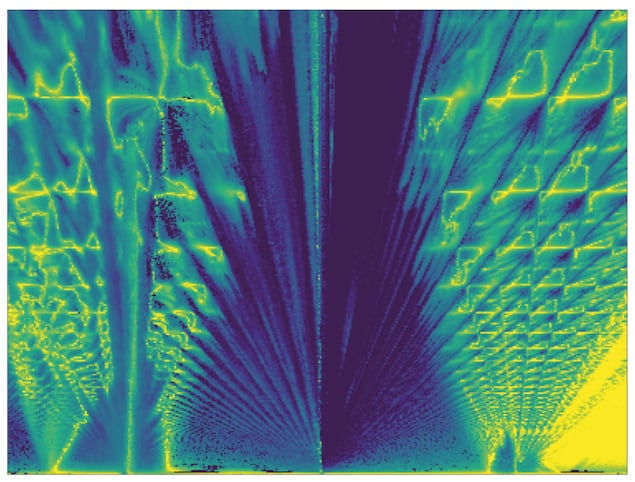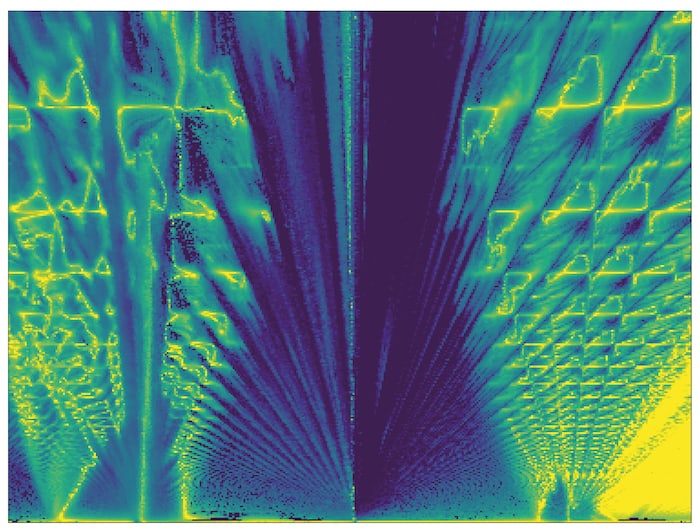 Andrei Geim and Alexey Berdyugin, along with two independent groups at the Massachusetts Institute of Technology and Columbia University in the US, observed a stunning fractal pattern in plots of electron density versus magnetic field strength in these graphene-hBN superlattices. This pattern, known as “Hofstadter’s butterfly”, emerged when the teams determined the energy spectrum of the superlattices by measuring their electrical conductivity in strong magnetic fields of up to 17 Tesla.
Andrei Geim and Alexey Berdyugin, along with two independent groups at the Massachusetts Institute of Technology and Columbia University in the US, observed a stunning fractal pattern in plots of electron density versus magnetic field strength in these graphene-hBN superlattices. This pattern, known as “Hofstadter’s butterfly”, emerged when the teams determined the energy spectrum of the superlattices by measuring their electrical conductivity in strong magnetic fields of up to 17 Tesla.
The Manchester researchers now report another surprising behaviour of electrons in such structures, again under strong magnetic fields. “It is well known that in a zero magnetic field, electrons move in straight trajectories and if you apply a magnetic field they start to bend and move in circles, which decreases the conductivity,” explain team members Julien Barrier and Piranavan Kumaravadivel, who carried out the experimental work. “In a graphene layer aligned with hBN, electrons also start to bend, but if you set the magnetic field at specific values, the conductivity increases sharply. It is as if the electrons moved in straight line trajectories again, like in a metal with no magnetic field anymore.”
Novel Brown-Zak quasiparticles
Such behaviour is “radically different from textbook physics”, Kumaravadivel says, and he and his colleagues attribute it to the formation of novel quasiparticles that represent a new class of metallic state. These quasiparticles are known as Brown-Zak fermions, and according to Berdyugin, they move at exceptionally fast ballistic speeds throughout the graphene-hBN structure despite the extremely high magnetic field. This is because, unlike electrons, which rotate with quantized orbits in the presence of a magnetic field, the Brown-Zak fermions follow a straight trajectory tens of microns long in magnetic fields of up to 16 T.
“Under specific conditions (that is, whenever the ‘cyclotron radius’ of the fermions is a multiple of the moiré lattice constant), we found that the fast-moving quasiparticles feel no effective magnetic field,” Barrier tells Physics World.
Implications for device engineering
The graphene used to prepare the Manchester team’s device is very pure, which makes it possible for the charge carriers within it to achieve mobilities of several million cm2/Vs. Such high mobilities imply that the charge carriers could travel straight across the entire device without scattering, and they are much sought after when fabricating 2D materials because they could make it possible to develop ultrahigh frequency transistors. Computer processors containing devices of this type would be able to perform a greater number of calculations in the same amount of time, resulting in a faster machine.

Fascinating fractals appear in graphene superlattices
The researchers say that the Brown-Zak fermions they observe are new metallic states that should be generic to any superlattice system, not just graphene. This makes their findings important for fundamental electron transport studies, as well as for characterizing and understanding novel superlattice devices based on 2D materials other than graphene.
Spurred on by this result, Barrier and his colleagues say they now plan to explore anomalous features of Brown-Zak fermions that do not match the Hofstadter theoretical framework. Full details of the research are reported in Nature Communications.
